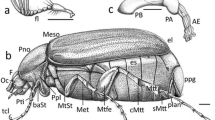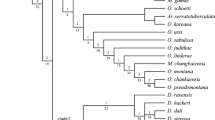Abstract
A cladistic analysis was applied to reveal the phylogenetic relationships among the Nymphaeales. Seventeen out of twenty three characters in gross morphology, anatomy and palynology were analyzed, for their evolutionary polarities. From the results of the present analysis, the phylogenetic status of each genus and their relationships were clarified: 1)Nelumbo is a distinct taxon and is presumed to have originated from an ancestral stock of the Nymphaeales; 2)Ceratophyllum has a close phylogenetic relationship withCabomba; and 3) in the Nymphaeaceaesensu stricto, Nuphar and the remaining genral constitute a monophyletic group.
A conclusion obtained from the present analysis was that the following three families should be recognized in the Nymphaeales; Nelumbonaceae Nymphaeaceae, and Ceratophyllaceae. The generaBrasenia andCabomba are traditionally classified in the Nymphaeaceae or in the independent family Cabombaceae. However, they should be included in the family Ceratophyllaceae.
Similar content being viewed by others
References
Bailey, I.W. andB.G. Swamy. 1951. The conduplicate carpel of dicotyledons and its initial trends of specialization. Amer. J. Bot.38: 373–379.
Brundin, L. 1972. Phylogenetics and biogeography. Syst. Zool.21: 69–79.
Burger, W.C. 1977. The Piperales and the Monocots. Alternate hypotheses for the origin of monocotyledonous flowers. Bot. Rev.43: 345–393.
Caspary, R. 1891. Nymphaeaceae.In: A. Engler and K. Prantl, ed., Die natürlichen Pflanzenfamilien, Part III, ser.2 Wilhelm Engelmann, Leipzig.
Carlquist, S. 1969. Toward acceptable evolutionary interpretations of floral anatomy. Phytomorphology19: 332–363.
Cronquist, A. 1981. An Integrated System of Classification of Flowering Plants. Columbia Univ. Press, New York.
Eames, A.J. 1961. Morphology of the Angiosperms. McGraw-Hill, New York.
Eckardt, T. 1937. Untersüchungen über Morphologie, Entwichlungs geschichte und systematische Bedeutung der pseudomonomenren Gynoeceums. Nova Acta Leopold. N. F.5: 1–112.
Erdtman, G. 1960. The acetolysis method. Sven. Bot. Tidskr.54: 561–564.
— 1966. An Introduction to Palynology, vol. 1: Pollen Morphology and Plant Taxonomy; Angiosperms. Hafner Publ., New York.
Hennig, W. 1966. Phylogenetic Systematics. Univ. Illinois Press, Urbana.
Hutchinson, J. 1973. The Families of Flowering Plants, 3 ed. Clarendon Press, Oxford.
Ito, M. 1983. Studies in the floral morphology and anatomy of Nymphaeales. I. The morphology of vascular bundles in the flower ofNymphaea tetragona George. Acta Phytotax. Geobot.34: 18–26.
— 1984. Studies in the floral morphology and anatomy of Nymphaeales. II. Floral anatomy ofNymphaea tetragona George. Acta Phytotax. Geobot.35: 94–102.
— 1986a. Studies in the floral morphology and anatomy of Nymphaeales. III. Floral morphology and anatomy ofBrasenia schreberi Gmel. andCabomba caroliniana A. Gray. Bot. Mag. Tokyo99: 169–184.
— 1986b. Studies in the floral morphology and anatomy of Nymphaeales. IV. Floral anatomy ofNelumbo nucifera. Acta Phytotax. Geobot.37: 82–96.
Li, H. 1955. Classification and phylogeny of Nymphaeaceae, and allied, families. Amer. Mid. Nat.54: 33–41.
Meeuse, A.D.J. 1966. Fundamentals of Phytomorphology. Ronald Press, New York.
Moseley, M.F. 1961. Morphological studies of Nymphaeaceae. II. The flower ofNymphaea. Bot. Gaz.122: 233–259.
— 1965. Morphological studies of Nymphaeaceae. III. The floral anatomy ofNuphar. Phytomorphology15: 54–84.
—,I.J. Metha, P.S., Williamson andH. Kosakai. 1984. Morphological studies of Nymphaeaceae. XIII. Contributions to the vegetative and floral structure ofCabomba. Amer. J. Bot.71: 902–924.
— andN.W., Uhl. 1985. Morphological studies of the Nymphaeaceae sensu lato. XV. The anatomy of the flower ofNelumbo Bot. Jahrb, Syst.106: 61–98.
Müller, J. 1970. Description of pollen grains ofOndinea purpurea den Hartog. Blumea18: 416–417.
Richardson, F.C. 1968. Morphological studies of Nymphaeaceae. IV. Structure and development of the flower ofBrasenia schreberi Geml. Univ. Calif. Publ. Bot.47: 1–101.
Schaffener, J.H. 1904. Some morphological pecularities of the Nymphaeaceae and Helobiae. Ohio Nat.4: 83–92.
Schneider, E.L. 1976. Morphological studies of the Nymphaeaceae. VIII. The floral anatomy ofVictoria Schomb. (Nymphaeaceae). Bot. J. Linn. Soc.72: 115–148.
—. 1978. Morphological studies of the Nymphaeaceae. IX. The seed ofBarclaya longifolia Wall. Bot. Gaz.139: 223–230.
— andM. Jeter. 1982. Morphological studies of the Nymphaeaceae. XII. The floral biology ofCabomba caroliniana. Amer. J. Bot.69: 1410–1419.
Sporne, K.R. 1974. Girdling vascular bundles in dicotyledons flowers. Gard Bull. Sing.29: 165–173.
Takhtajan, A. 1969. Flowering Plants. English ed. Oliver and Boyd Ltd., Edinburgh.
—. 1980. Outline of the classification of flowering plant (Magnoliophyta). Bot. Rev.46: 225–359.
Tamura, M. 1982. Relationship ofBarclaya and classification of Nymphaeales Acta Phytotax. Geobot.33: 336–345 (in Japanese with English summary).
Thorne, R.F. 1983. Proposed new realignments in the angiosperms. Nord. J. Bot.3: 85–117.
Troll, W. 1933. Beitrage zur Morphologie des Gynaeceums. 4 Über das Gynaeceum der Nymphaeaceen. Planta21: 447–485.
Walker J.W. 1974a. Evolution of exine structure in the pollen of primitive angiosperms. Amer. J. Bot.61: 891–902.
— 1974b. Aperture evolution in the pollen of primitive angiosperms. Amer. J. Bot.61: 1112–1136.
—. 1976a. Comparative pollen morphology and phylogeny of the ranalian complex.In: C.B. Beck, ed., Origin and Early Evolution of Angiosperms p. 241–299. Columbia Univ. Press, New York.
— 1976b. Evolutionary significance of the exine in the pollen of primitive angiosperms.In: I.K. Ferguson and J. Müller, ed., The Evolutionary Significance of the Exine p. 251–308. Academic Press, London.
Weidlich, W.H. 1976a. The organization of the vascular system in the stem of the Nymphaeaceae. I.Nymphaea subgeneraCastalia andHydrocallis. Amer. J. Bot.63: 499–509.
—. 1976b. The organization of the vascular system in the stem of the Nymphaeaceae. II.Nymphaea subgeneraAnecphua, Lotus and,Brachyceras. Amer. J. Bot.63: 1365–1379.
Wiley, E.O. 1981. Phylogenetics. Wiley-Interscience Publ., New York.
Author information
Authors and Affiliations
Rights and permissions
About this article
Cite this article
Ito, M. Phylogenetic systematics of the nymphaeales. Bot. Mag. Tokyo 100, 17–35 (1987). https://doi.org/10.1007/BF02488417
Received:
Accepted:
Issue Date:
DOI: https://doi.org/10.1007/BF02488417




